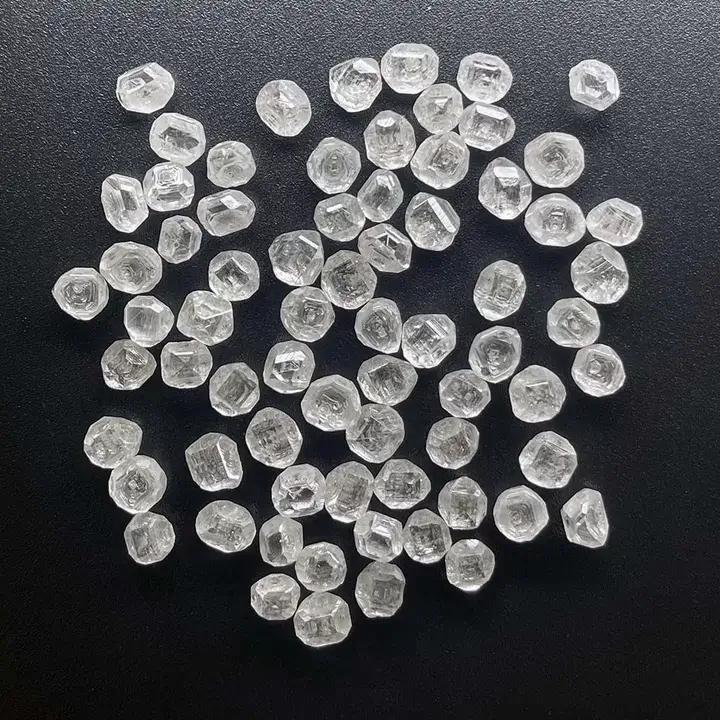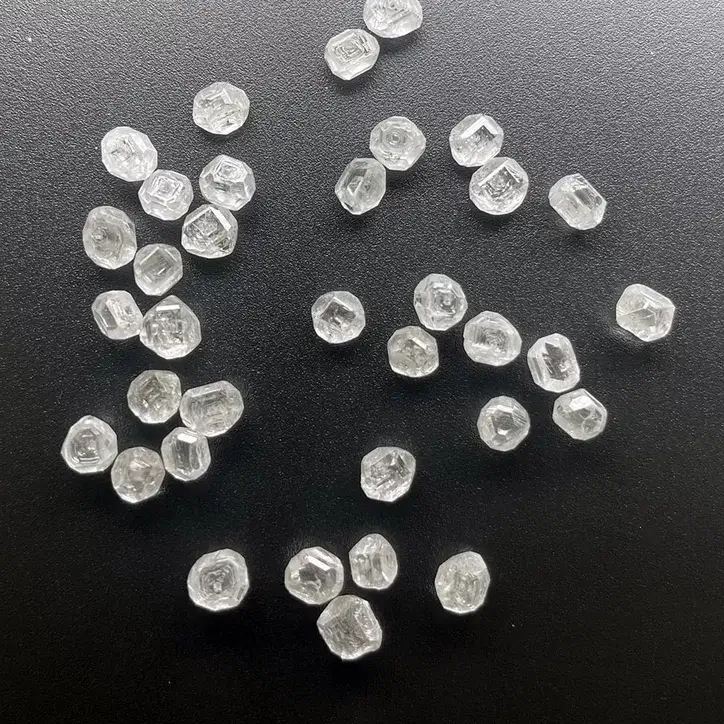Full White 1 Carat Rough Lab Grown Diamonds For Making Lab Grown Diamond Jewelry
Rough Lab Grown Diamonds Description
Lab grown diamonds are the diamonds grown in the laboratory. People use advanced equipment to mimic the environment of natural diamond formation. Diamond crystals are used as seeds to induce the growth of diamond crystals. The physical and chemical properties of man-made diamonds are exactly the same as those of natural diamonds. At present, high quality synthetic diamonds are mainly used in jewelry.
Currently there are two main methods to make lab grown diamonds. They are chemical vapor deposition (CVD) and high pressure high temperature (HPHT) methods.
What’s the difference between laboratory diamonds and simulated diamonds? Unlike laboratory grown diamonds, simulated diamonds are not real diamonds. Although the shape of simulated diamond is similar to that of real diamond, it is made of seed materials such as glass or cubic zirconia. This makes it impossible for silicon carbide and other simulated diamonds to have the hardness and optical properties of diamond grown in laboratory. Over time, they are more likely to wear out and lose luster.
Can we distinguish between laboratory diamonds and natural diamonds? yes. However, only diamond professionals can identify the difference between laboratory grown diamonds and natural diamonds by using professional diamond identification equipment.
Why Buy Rough Lab Grown Diamonds?


The reasons to buy Rough Lab Grown Diamonds may surprise you. While diamonds can be graded using GIA grading reports, some gemologists prefer to purchase rough lab grown diamonds because they produce fewer emissions and higher value for consumers. Besides that, they have more margin for retailers and are reported using broader category terms. This means they are often more expensive than natural diamonds, but that doesn’t mean they are less valuable.
Less carbon emissions
While it is difficult to compare the carbon emissions generated by mined and lab-grown diamonds, one recent report suggests that mining a natural diamond creates three times less greenhouse gas emissions than growing a diamond in a laboratory. According to the Diamond Producers Association, which represents seven of the world’s largest diamond miners, the process for growing a lab-grown diamond has fewer environmental impacts than that of mining a natural diamond.
The diamond mining industry produces enormous amounts of CO2, and the DPA report highlights areas for improvement. Moreover, it establishes a baseline for future progress toward achieving environmental goals. Carbon dioxide emissions from diamond mining are responsible for the bulk of the diamond’s environmental impact, with seven DPA mines emitting up to 160 kg of CO2 per polished carat. This is higher than the carbon emissions from a 15-inch, 265GB Apple MacBook Pro. In comparison, a lab-grown diamond creates 511 kg of CO2, which is considerably lower than the emissions from a mined diamond.
The cost of mined diamonds is higher than that of lab-grown diamonds, as they are mined by small-scale miners in conflict zones and poor working conditions. And diamonds are sold in lots, and the majority of consumers have no idea where a particular diamond came from. In contrast, a lab-grown diamond producer can point to a specific machine, and thus prove that the diamond came from a lab rather than a mine.
However, despite the higher cost of manufacturing lab-grown diamonds, the environmental impact of mining natural diamonds is still quite high. Because they involve significant energy, natural diamonds require hundreds of meters of earth to reach the surface. Therefore, sustainable mining methods are nearly impossible. By contrast, synthetic diamonds are largely free of the same energy and environmental impact. This means that lab-grown diamonds are less environmentally friendly than marketing suggests.
Better value
As the cost of mined diamonds continues to fall, lab-grown diamonds are becoming the preferred choice for jewelry buyers. Their superior quality and low cost per carat also help retailers earn a higher margin. While many people are concerned about the environmental impact of diamond production, many consumers are choosing lab-grown diamonds for their engagement rings and wedding bands. Purchasing a lab-grown diamond makes consumers feel better about their purchase and can last for generations.
While lab-grown diamonds are often less expensive than natural diamonds, they do not have the same luster and brilliance as natural diamonds. In addition, they’re harder to resell, making them more desirable as gifts. In fact, the most popular shapes for lab-grown diamonds are round brilliant, oval, and Asscher. They’re all great options for engagement rings, but some couples prefer to double down on the carat instead.
When buying lab-grown diamonds, check the clarity and cut. While the Cs (Carat, Color, and Clarity) are all the same, some labs are better than others. A perfect cut is more expensive than a good or very good one. Another factor affecting the price of a lab-grown diamond is its carat weight. The higher the carat weight, the better value it is.
Lab-grown diamonds are still fairly cheap compared to natural diamonds, but their prices are still higher than those of mined diamonds. In addition, the market for lab-grown diamonds is not yet uniform, meaning the prices of each kind of stone aren’t uniform. Natural diamond prices are set by three companies, and they rise and fall depending on demand and supply. Lab-grown diamond prices, on the other hand, vary from producer to producer.
More margin for retailers
More margin for retailers with rough lab grown diamond jewelry is a reality for the industry. While the market for natural diamond jewelry is saturated with lower-quality alternatives, LG-set jewelry is still a good buy. In the last two years, the number of retailers that offer LG-set jewelry has grown by leaps and bounds, and demand is thriving. Despite the price differences, retailers are more than happy to take advantage of this up-and-coming product.
Several retailers have taken the initiative to start selling lab-grown diamonds. While costs have lowered significantly, margins remain high and demand continues to rise. Another reason to sell lab-grown diamond jewelry is the growing awareness of ESG among younger consumers. For example, Signet, the world’s largest diamond retailer, has aggressively expanded its lab-grown bridal line, bringing more margin to the industry.
One of the main concerns about buying man-made diamonds is their environmental impact. Even if they are grown in labs, diamond mining still requires raw minerals and energy to make them. In China, for example, coal is used to power its power plants. The industry is also concerned with environmental impacts, so it’s worth comparing the carbon footprint of man-made and natural diamonds to choose which is more environmentally sound.
Retailers can also offer rough diamonds on consignment for increased margins. Man-made diamonds typically have lower production costs than natural diamonds, and retailers can offer these diamonds on consignment to customers. Because man-made diamonds are manufactured goods, retailers have lower capital costs for inventory and can be more selective with discounts to consumers. This can translate into more margin for retailers with rough lab grown diamonds.
GIA grading reports
Previously, GIA only graded mined diamonds. But the GIA has taken a small step toward accepting lab-grown diamonds. This policy change will help both the industry and consumers by ensuring consistency. While GIA has never had a vested interest in any particular industry, the GIA does stand for information and educational purposes, which is why they are willing to change.
The GIA has been grading lab-grown diamonds since 2007. Until recently, GIA grading reports for these stones were confined to the color and clarity range of mined diamonds. The GIA now plans to expand their offerings in this space and welcome new customers. The new reports are available online only, and come with QR codes directing consumers to an GIA education page.
GIA certificates accompany most major stones. The certificates are typically accompanied by an invoice or other document containing the diamond’s price and other information. However, the GIA certificate is not the only certificate for rough lab grown diamonds. GCAL is a smaller, but well-known lab based in New York. They guarantee the quality of diamonds, decide on the accuracy of grading reports and create customized documents for retailers. The reports also come with a Gemprint of the diamond, allowing consumers to easily identify it if it was ever lost.
In addition to the GIA report, the IGI report contains information about post-growth treatments. This information can help consumers in determining which diamonds are worth more money. This is an excellent way to find a diamond with the right quality. However, if you’re unsure of what kind of diamond you’re buying, it’s wise to consult a certified gemologist before making a purchase.
WD’s ability to take custom orders on specific shapes, sizes and quality
The advantages of Rough Lab Grown Diamonds over traditional mined diamonds include a variety of custom order options for different quality and shape specifications. Diamonds created in a laboratory require much less water than mined diamonds, reducing the carbon emissions that result from the mining process. They are also much easier to work with than natural diamonds, which require skilled cutters to polish them.
One major advantage of Rough Lab Grown Diamonds is that the process of creating these gems is more accurate than with natural diamonds. Unlike natural diamonds, lab-grown diamonds are formed deep within the Earth’s mantle. After being thrust into the Earth’s surface by volcanic eruptions, natural diamonds have been found by miners for centuries.
Full White 1 Carat Rough Lab Grown Diamonds For Making Lab Grown Diamond Jewelry














